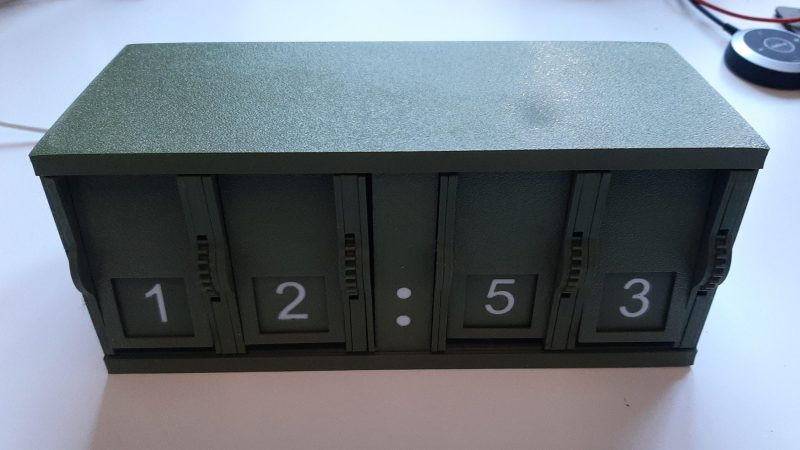Hackers like making clocks, and we like reporting on them around these parts. Particularly if they’ve got a creative mechanism that we haven’t seen before. This fine timepiece from [gooikerjh] fits the bill precisely—it’s a sliding tile clock!
The brains of the build is an Arduino Nano ESP32. No, that’s not a typo. It’s basically an ESP32 in a Nano-like form factor. It relies on its in-built WiFi hardware to connect to the internet and synchronize itself with time servers so that it’s always showing accurate time. The ESP32 is set up to control a set of four stepper motors with a ULN2003 IC, and they run the neat time display mechanism.
All the custom parts are 3D printed, and the sliding tile concept is simple enough. There are four digits that show the time. Each digit contains number tiles that slide into place as the digit rotates. To increment the digit by one, it simply needs to be rotated 180 degrees by the relevant stepper motor, and the next number tile will slide into place.
We love a good clock at Hackaday—the more mechanical, the better. If you’re cooking up your own nifty and enigmatic clocks at home, don’t hesitate to drop us a line!
















I like it.
I’ve seen that type of mechanism. I think it was on a little desk calendar. Never thought about making a clock out of them.
Now I need to go see how those things work. I’m stuck on something to do with changing numbers on a larger scale in a compact space and wonder if I can adapt that mechanism.
Ah, now I see. Gravity is your friend. Odd numbers on one side of the tile, even on the other, odds at 0 degrees orientation, evens at 180 rotation.
Unsure if it matters whether the odd on a tile is higher or lower value than the even on the back side of the same tile. Without thinking too deeply about it, I think that correlation would depend on the desired direction of rotation.
This post shows the tile exposed at the bottom of the housing where other flip, perpetual calendar examples online expose the tile at the top. Which way up the tile is placed would change depending on whether it’s to be displayed at top or bottom.
Yep, perpetual calendar. Been around for yonks, I once made a photo album based on it.
Not quite sure why he put the “window” at the bottom. It doesn’t matter where you put it, but at the top looks much better.
“You must turn the digits all to zero when you power up the clock.”
Darn. I clicked through hoping to find a clever zero-sense mechanism.
Maybe a hole in the end of the tile housing that faces down toward the base to expose –say a white edge on the zero tile– through the hole such that an emitter/detector pair in the base can look upward and discriminate between the white edge of the zero tile, and black edges of all other tiles. If that makes any sense.
Same thing might apply to looking downward at said hole and seeing the marked “when-you-see-me-the-zero-is-showing-below” tile. Seems to be more room up in the top for something like that, but will that particular tile be reliably positioned? The “gap” where there is no tile will always be up at the top so the upper stack wouldn’t be as stable as the lower stack.
Not my circus, not my monkey but entertaining to think about for a few minutes. :-)
Magnet & reed switch.
Nope, I don’t see how this works at all and the instructables page doesn’t show the detail either.
Here: https://i.imgur.com/goVJj2Z.mp4. From this post: https://hackaday.com/2018/03/23/diy-perpetual-flip-calendar/
Make 4 of those, drive with whatever. Geneva drive would be neat.